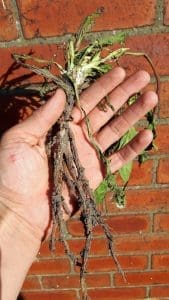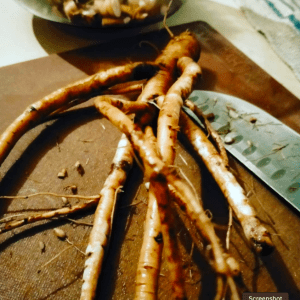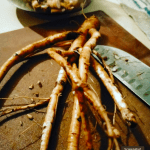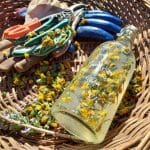As a nature enthusiast and coffee lover the dandelion espresso martini is my dream, there’s nothing more satisfying than incorporating wild ingredients into my daily routine. One plant that is often overlooked but holds tremendous potential is the humble dandelion. In this article, we will explore the art of foraging dandelion roots and how they can be transformed into a delightful cup of dandelion root coffee, before making a brilliant twist on the espresso martini.
Dandelions are often considered pesky weeds, but they are so much more than that. Every part of the dandelion plant can be utilised, from its vibrant yellow flowers to its nutritious leaves and, of course in this instance its roots. These resilient plants are packed with vitamins and minerals, making them a valuable addition to any diet. So, instead of cursing their presence in your garden, embrace the abundance of dandelions and explore the endless possibilities they offer.
The Benefits of Dandelion Root Coffee
Dandelion root coffee is a fantastic alternative to traditional coffee, especially for those looking to reduce their caffeine intake or exploring new flavours. Besides being caffeine-free, dandelion root coffee boasts a variety of health benefits. It’s said to aid digestion, support liver health, and is rich in antioxidants. Additionally, dandelion root coffee has a similar taste profile to regular coffee, with earthy and slightly bitter notes. So, if you’re ready to embark on a new coffee adventure, dandelion root coffee could be a perfect choice.
Digging your Dandelion Roots
- Choose a suitable location: Look for dandelions in pesticide-free areas such as meadows, parks, or your own backyard.
- Identify the plant: Dandelions have distinct yellow flowers and toothed leaves. Once you spot them, trace the stem down to the root.
- Dig carefully: Using a garden fork or trowel, dig around the base of the plant, making sure to loosen the soil. Gently pull the root out, taking care not to damage it.
- Collect the roots: Shake off excess soil and place the dandelion roots in a basket or bag. Remember to only take what you need, leaving some behind for future growth.
- Only dig up dandelion roots from places where you have permission (there’s actually a law stopping us from digging up any plants from places we don’t have permission)
By following these simple steps, you can gather an ample supply of dandelion roots for your coffee-making adventures.
I actually find the best places to big up dandelion roots are on allotments, turn up to your local allotment and offer to dig them up and people tend to fall over backwards to have you ‘weed’ their allotments. Even better the soft soil on allotments makes digging these up even easier.
Click here for a Guide on Foraging Dandelion

How to Prepare Dandelion Roots for Dandelion Espresso Martini
Before you can transform dandelion roots into a delicious cup of coffee, they need to be properly cleaned and prepared. Here’s how you can do it:
- Rinse: Start by rinsing the dandelion roots under cold water to remove any dirt or debris.
- Scrub: Using a vegetable brush, gently scrub the roots to ensure they are thoroughly clean.
- Trim and discard: Trim off any damaged or heavily browning areas and discard them. Focus on the main roots, as these are the ones you will be using for your coffee.
- Dry: Once cleaned, pat the dandelion roots dry with a clean towel.

Now that your dandelion roots are clean and ready, it’s time to roast them before we make a brew.
Roasting your Dandelion Roots
- Roast the roots: Preheat your oven to 125°. Spread the cleaned & chopped dandelion roots on a baking sheet and roast them for about 45 minutes or until they turn dark brown. Chop the roots into 1cm pieces. Make sure the roots don’t overlap each other, they need to be well spaced out.
- The key to making this work well is to leave the oven door open for the first 15 minutes to dry them out a little.
- Grind the roots: Once roasted, allow the dandelion roots to cool completely. Then, grind them using a coffee grinder or a mortar and pestle until you have a coarse powder.
- Brew: Add 1 tablespoon of ground dandelion root coffee per person, approx 200ml of boiling water in your French press & Brew it as you would regular coffee.
- Pour the brewed dandelion root coffee into a mug and savour the unique flavours. You can add your preferred sweeteners or milk alternatives to enhance the taste.

Now for our Dandelion Espresso Martini
If you’re looking to add a touch of sophistication and excitement to your dandelion root coffee, an espresso martini is the perfect choice. This delectable cocktail combines the richness of dandelion root coffee with the smoothness of vodka and the sweetness of coffee liqueur. Here’s how you can make a dandelion root coffee espresso martini:
Ingredients:
- 2 shots of dandelion root coffee
- 2 shots of vodka,
- 1 shot of coffee liqueur,
- 1 shot of sugar syrup,
- Ice cubes
Method:
- In a cocktail shaker: Add the dandelion root coffee, vodka, coffee liqueur, and syrup.
- Add ice to the shaker.
- Shake vigorously for about 30 seconds to combine the flavours and chill the drink.
- Strain and serve: Strain the dandelion espresso martini cocktail into a martini glass

Cheers and enjoy: Raise your glass, take a sip, and revel in the delightful combination of flavours. The smoothness of the vodka and the richness of the dandelion root coffee create a truly extraordinary experience.
Other Cocktail Variations Using Dandelion Root Coffee
While the dandelion root coffee espresso martini is undoubtedly a delightful choice, there are several other cocktail variations you can explore using dandelion root coffee. Here are a few ideas to inspire your mixology adventures:
- Dandelion Mocha Martini: Add a shot of chocolate liqueur to your dandelion root coffee espresso martini for a decadent twist.
- Dandelion Vanilla Latte Martini: Infuse your dandelion root coffee espresso martini with the smoothness of vanilla by adding a shot of vanilla vodka.
- Dandelion Irish Coffee Martini: Combine dandelion root coffee, Irish whiskey, and a dollop of whipped cream for a delightful Irish-inspired cocktail.
Please experiment with different ingredients and create your own signature dandelion root coffee cocktails. The possibilities are endless!
So, the next time you come across a field of dandelions, don’t disregard them as weeds. Grab your basket, and embark on a foraging adventure. Discover the magic hidden beneath the earth’s surface and let it inspire your coffee-making skills.
For more Dandelion recipes click here.











